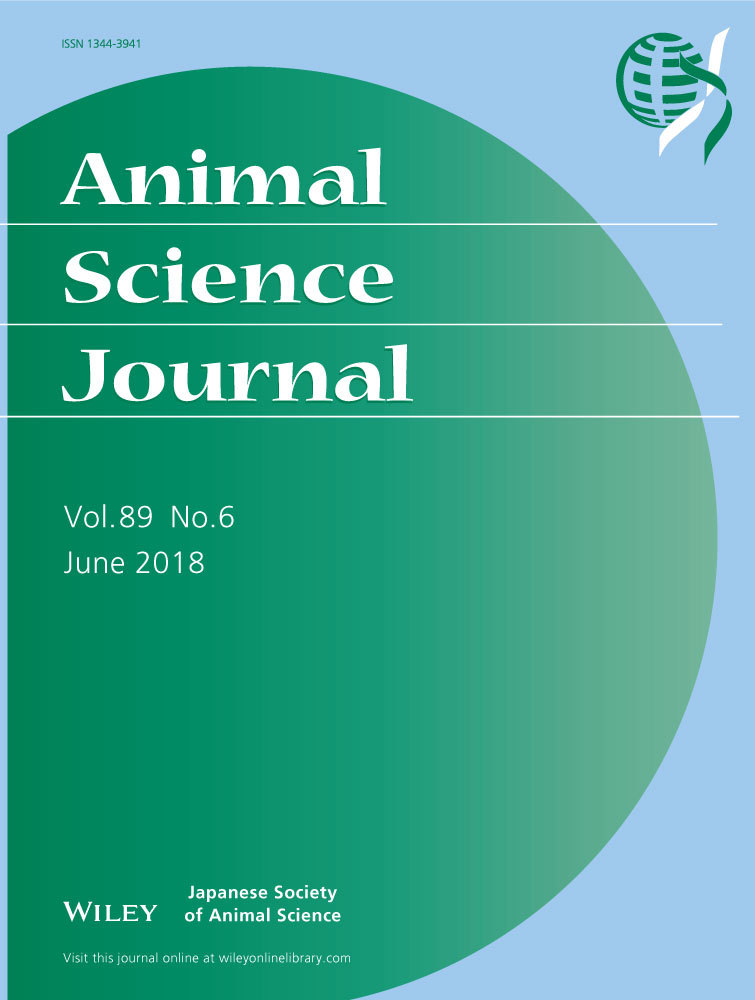Mortality in rabbits transported for slaughter
Abstract
During transport rabbits may be exposed to various stressors which can compromise both their welfare and meat quality. Mortality related to the commercial transport of rabbits for slaughter was analyzed in the Czech Republic in the period from 2009 to 2016. The overall transport-related mortality of rabbits was 0.19%. Transport distance was found to have an impact on rabbit mortality; significantly (p < .001) greater losses were found in rabbits transported over longer distances. Mortality rates ranged from 0.02% in rabbits transported over distances of less than 50 km to 0.29% in rabbits transported over distances exceeding 400 km. A significantly (p < .001) increased risk was also associated with shipments in which 500 and more rabbits were delivered per batch. No effect of season was found. Our results show that rabbits can be transported within a wide range of temperatures (from −5 to 19.9°C) with no negative impact on mortality in transit. However, journeys carried out at temperatures below −5°C and above 20°C were associated with increased death losses (0.17% and 0.15%, respectively).
1 INTRODUCTION
Transportation for slaughter is considered a major stressor for farm animals. It may have deleterious effects on their health and well-being as well as product quality (Verga, Luzi, Petracci, & Cavani, 2009). The welfare of rabbits during transport depends on the attitudes and handling procedures used by farmers, hauliers and abattoir personnel, as well as transport logistics (Buil, Maria, Villarroel, Liste, & Lopez, 2004), particularly because there is no specific legislation for mandatory minimum requirements for the protection of rabbits in agriculture in the majority of European Union Member States. Rabbits are now stated to be the species in which animal welfare and species-specific needs are the most overlooked in the European Union despite rabbits being the fourth most farmed animal in the world and the second most farmed species in the European Union with over 326 million slaughtered for meat every year (Eck, 2016).
During transport rabbits may be exposed to various stressors which can compromise both their welfare and meat quality. Several key factors have been identified, including deprivation of feed and water (Jolley, 1990; Verga et al., 2009), the loading method (Buil et al., 2004; Mazzone, Vignola, Giammarco, Manetta, & Lambertini, 2010; Verga et al., 2009), journey distance and duration (Lambertini, Vignola, Badiani, Zaghini, & Formigoni, 2006; Liste et al., 2006, 2008; Maria et al., 2006, 2008; Petracci, Bianchi, Biguzzi, & Cavani, 2010), stocking density (De la Fuente, Salazar, Ibanez, & de Chavarri, 2004), crate position on vehicle (Buil et al., 2004; Liste et al., 2006, 2008), noise (De la Fuente, Diaz, Ibanez, & de Chavarri, 2007), social disruption and an unfamiliar environment (De la Fuente et al., 2007; Sabuncuoglu et al., 2011), lairage duration (Buil et al., 2004; Liste et al., 2009; Petracci et al., 2010; Verga et al., 2009), and environmental conditions (Buil et al., 2004; De la Fuente et al., 2004, 2007; Liste et al., 2006, 2008; Maria et al., 2006, 2008; Petracci et al., 2010).
Depending on the type and level of stress, transported animals respond to transport by changes in behavior, changes in hematological and biochemical parameters, subclinical and clinical health disorders and ultimately death. The number of animals that die during transport or shortly after transport ends may serve as a critical indicator of animal welfare during the course of the transportation process (Simova, Voslarova, Vecerek, Passantino, & Bedanova, 2017). Only scarce evidence is available on mortality rates related to the commercial transport of rabbits. In Italy, Petracci et al. (2010) reported mean transport-related mortality of 0.09%, ranging from 0% to 1.3%, in 2006. When compared with findings recorded in Italy in other species, preslaughter mortality of rabbits was slightly higher than that recorded in swine and bovine, while it was much lower compared to mortality rates reported in poultry which are transported using similar procedures and equipment.
There is a wide range of stressors that affect rabbit welfare and these differ between regions (Buil et al., 2004). The aim of the present study was to assess mortality related to the commercial transport of rabbits for slaughter in the Czech Republic, to determine the effect of transport distance, batch size, season and external air temperature on rabbit mortality and, in addition, to identify developmental trends in the numbers of rabbits dying in the process of being transported for slaughter in the monitored period.
2 MATERIALS AND METHODS
Mortality related to the commercial transport of rabbits for slaughter was analyzed. Data on individual shipments were collected by the inspectors of the State Veterinary Administration of the Czech Republic from January 1, 2009 to December 31, 2016. The veterinary inspectors recorded the numbers of rabbits transported for slaughter and the mortality related to such transport, for example the number of rabbits that died directly in the means of transportation or in the slaughterhouse shortly after transport. The dataset comprised 2,974 loads, transporting a total of 1,393,212 rabbits from 177 farms to nine slaughter plants. The transport of rabbits from farms to slaughterhouses was carried out by authorized transporters by means of road transport using trucks specifically designed and approved for transportation of rabbits. The transport conditions for all journeys were in compliance with Council Regulation (EC) No 1/2005 of December 22, 2004 on the protection of animals during transport and related operations and amending Directives 64/432/EEC and 93/119/EC and Regulation (EC) No 1255/97 (Council of the European Union 2005). Rabbits were transported in standard crates made of plastic wire measuring 100–110 × 50–60 × 22–30 cm (length × width × height). The crates were placed on the vehicle in multi-floor crate roller stands. In compliance with the law, feed withdrawal before slaughter did not exceed 12 hr including transportation and lairage. The data were analyzed with a program specifically created for this purpose; on request, this program generated reports about the numbers of transported rabbits that died and converted them into Excel format for further statistical processing. For every rabbit shipment, numbers of transported rabbits and the numbers of rabbits that died were recorded in absolute numbers and mortality in percentages was calculated for every load. Subsequently, the mean transport-related mortality was calculated for every year in the monitored period.
The impact of transport distance on rabbit mortality in relation to transport to the slaughterhouse was determined in such a way that all rabbit shipments were divided according to the distance travelled between the farm and the slaughterhouse into six categories (transport distances): up to 50 km, 51–100 km, 101–200 km, 201–300 km, 301–400 km and above 400 km. Mean transport-related mortality per load was calculated for each category.
In order to assess the impact of batch size, all rabbit shipments were divided into three categories according to the number of rabbits per load: <500, 500–1,500, above 1,500. Mean transport-related mortality per load was calculated for each category.
The seasonal impact on the mortality of rabbits during their transport to the slaughterhouse was shown by the four seasons, namely spring (March, April, May), summer (June, July, August), autumn (September, October, November) and winter (December, January, February). This was determined in such a way that all rabbit shipments were divided according to the season in which the journey was undertaken. Mean transport-related mortality per load was calculated for the individual seasons over the whole monitored period.
In order to assess the impact of external air temperature on the mortality of rabbits during their transport to slaughter plants, external air temperatures were determined for the times and locations of individual rabbit shipments in co-operation with the Czech Hydrometeorological Institute, Prague, Czech Republic. In the monitored period, the external air temperature under which individual shipments were undertaken ranged from −5.2 to 21.3°C. For the purposes of our study, all rabbit shipments were divided into seven categories (temperature intervals): below −5°C, −5 to −0.1°C, 0 to 4.9°C, 5 to 9.9°C, 10 to 14.9°C, 15 to 19.9°C and above 20°C. Mean transport-related mortality per load was calculated for each category.
The results were analyzed using the statistical package Unistat v. 6.5. (Unistat Ltd., London, UK). Data were tested for normality by means of a Kolmogorov–Smirnov test (Zar, 1999) and, in view of the fact that they were not normally distributed, non-parametrical methods were used for testing. Data concerning mortality rates in rabbits as affected by the categories of interest (i.e. year, transport distance, season, external air temperature, batch size) for the entire period monitored in the study were subjected to a Kruskal–Wallis one-way analysis of variance and subsequently to a non-parametric Tukey-type test with ranked sums (Zar, 1999) as a post hoc test for pairwise comparisons. A Spearman rank correlation coefficient (Zar, 1999) including its significance was calculated to assess the trend in mortality rates during the monitored years. A p value of .05 in tests was considered significant.
3 RESULTS
Of 1,393,212 rabbits transported for slaughter in the Czech Republic from 2009 to 2016, 2,647 (0.19%) died from causes connected with transport. In individual shipments, transport-related mortality ranged from 0% to 4.5% (Figure 1). More than 90% of loads did not exceed 0.5% mortality and almost 80% of loads arrived with no dead rabbits. A significantly (p < .001) greater transport-related mortality in rabbits was found in shipments in which 500 and more rabbits were delivered per batch (Figure 2).
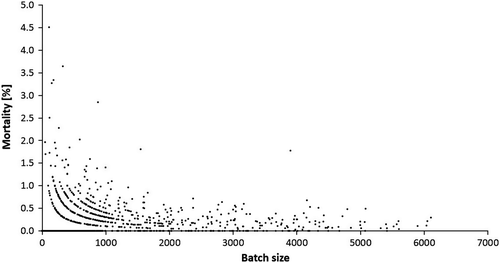
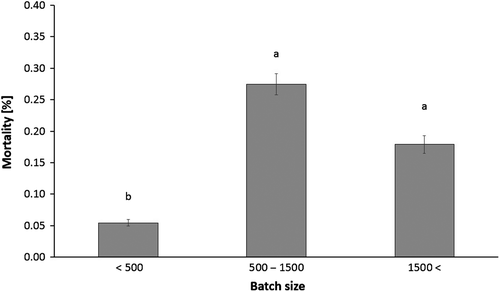
Transport distance was found to have a significant impact on the transport-related mortality in rabbits (Figure 3). The lowest mortality was found in rabbits transported over distances of up to 50 km (0.02%) and from 51 to 100 km (0.05%), with no significant difference (p > .05) between these two categories. Significantly (p < .001) greater losses were found in rabbits transported over longer distances. The highest losses (0.29%) were recorded for distances exceeding 400 km; they were significantly (p < .01) greater than those in any shorter distance category.
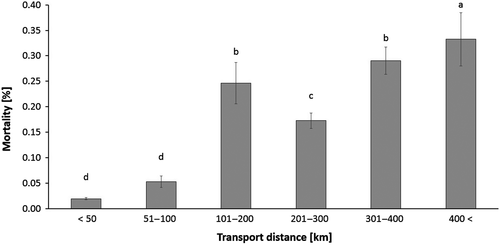
No seasonal impact on the transport-related mortality of rabbits transported for slaughter in different seasons of the year was found (Figure 4). Slightly higher losses were found in rabbits transported in summer and winter (0.11%) than in spring and autumn (0.08%), However, the difference was not statistically significant (p > .05). The impact of external air temperature on the transport-related mortality of rabbits is shown in Figure 5. Journeys carried out under temperatures below −5°C and above 20°C were associated with the highest death losses (0.17% and 0.15%, respectively). They were significantly greater than the mortality of rabbits related to transport under temperatures ranging from 10 to 14.9°C (0.07%), that is the temperature category associated with the lowest losses.
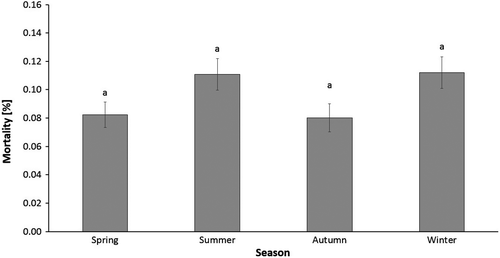
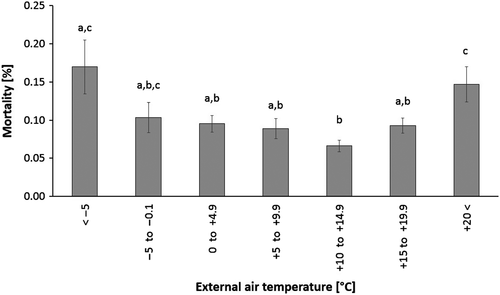
The trend in transport-related mortality in rabbits in the period from 2009 to 2016 is shown in Figure 6. The highest mortality was found in 2009 (0.16%), whereas the lowest mortality in rabbits transported for slaughter was found in 2015 (0.03%). A significant negative correlation (r = −.9524, p = .0003) was found between mortality rates in rabbits and monitored years indicating a decreasing tendency in rabbit losses in the monitored period.
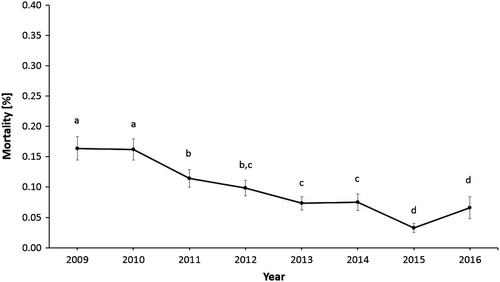
4 DISCUSSION
In contrast to other farm animals, in which transport-related mortality has been largely studied and evaluated in terms of animal welfare worldwide, there are no recent published estimates of rates of rabbits dead on arrival at the slaughter plant. The only attempt to identify and quantify risk factors associated with the mortality and injury rate occurring between the catching and slaughter of rabbits was made by Petracci et al. (2010). They analyzed 975 batches shipped for slaughter from 79 farms in Italy throughout 2006 and found a mean transport-related mortality of 0.09%, ranging from 0% to 1.3%. On the basis of comparisons with transport-related mortality rates recorded in Italy in other species, they concluded that overall rabbits are fairly resistant to preslaughter stressors. However, in our study, death losses of rabbits associated with their transport for slaughter in the Czech Republic from 2009 to 2016 were double on average and ranged from 0% to 4.5% in individual shipments. Furthermore, comparisons of transport-related mortality rates of farm animals transported for slaughter in the Czech Republic in recent years are not favorable. They revealed that death losses in rabbits exceeded those in most other species of animals kept for meat production. In fact, greater mortality rates (0.37%) were found only in broiler chickens (Vecerek, Voslarova, Conte, Vecerkova, & Bedanova, 2016). Otherwise, the preslaughter mortality of rabbits was greater than that recorded in swine (0.07%, Voslarova, Vecerek, Passantino, Chloupek, & Bedanova, 2017) and bovine animals (0.02%, Simova, Voslarova, Passantino, Bedanova, & Vecerek, 2016; Simova et al., 2017), as well as in poultry with the exception of broiler chickens, that is ducks (0.08%, Voslarova, Hytychova, Vecerek, Nenadovic, & Bedanova, 2016) and turkeys (0.15%, Machovcova et al., 2017). The overall high losses in rabbits found in our study are more likely to result from varying transport conditions than from rabbits' higher sensitivities to transport stress. It has been shown by Petracci et al. (2010), as well as by the data on the majority of loads monitored in our study, that losses in transit can be comparatively low. More than 90% of the loads recorded in our study did not exceed 0.5% mortality. Hoever, the remaining loads are of welfare concern. As outlined in the Introduction, the lack of legislation and varying attitudes and practices (Buil et al., 2004; Eck, 2016) make rabbits the species for which animal welfare and species-specific needs are most overlooked in the European Union. Current animal welfare regulations set strict rules on transportation conditions for most animals, but they are vague (and leave room for discretionary decisions) regarding rabbits (Lambertini et al., 2006). Nevertheless, a positive finding is that a significant negative correlation between mortality rates and monitored years in rabbits was found in our study, indicating a general decreasing tendency in rabbit losses over the monitored period. Further reduction in transport-related mortality rates in rabbits can be achieved by the adoption, application and enforcement of uniform regulations ensuring the required level of rabbit welfare in transit.
Furthermore, factors affecting transport-related mortality in rabbits should be taken into consideration. Our results show that the likelihood of death losses in transported rabbits increases with increasing transport distance. The transport-related mortality ranged from 0.02% in rabbits transported over distances of less than 50 km to 0.29% in rabbits transported over distances exceeding 400 km. Despite less than half the rabbits being transported over distances of more than 100 km, such journeys accounted for 63.36% of death losses. Similarly, Petracci et al. (2010) reported that increasing journey durations increase the risk of death during the preslaughter period. Rabbits transported and laired for longer times had a threefold higher risk of death. Specifically, the death risk was significantly increased if transport lasted more than 205 min and lairage duration was longer than 75 min. Data on the transport duration for journeys analyzed in our study were not available, but it can be deduced that total transport duration also increases with increasing transport distance. In some studies, a deterioration of meat quality was also reported when rabbits were subjected to longer journeys (Lambertini et al., 2006; Liste et al., 2006; Maria et al., 2006; Petracci, Bianchi, Venturi, Cremonini, & Cavani, 2009; Trocino, Xiccato, Queaque, & Sartori, 2003). According to Liste et al. (2009), even slight negative effects on meat quality probably represent serious welfare problems during pre-slaughter handling since the level of stress required to substantially decrease meat quality is higher than the level required to affect plasmatic stress indicators.
The total duration of transport (commencing when the first animal is loaded into a container and ending when the last animal is unloaded from a container) is also affected by the number of rabbits in the load, as larger batches usually mean an increased catching time. Buil et al. (2004) reported loading time to range from 10 to 240 min in a survey of rabbit transport in Spain. Correspondingly, death losses several times higher were found in shipments in which 500 or more rabbits were delivered per batch than in smaller batches in our study. Petracci et al. (2010) found not only a higher mortality risk but also an increased risk of bruising in very large batches (>3,681 rabbits). They attribute this to the human factor, that is to catchers being less careful when dealing with a large load. The human–animal relationship plays a key role in handling commercial rabbits (Trocino & Xiccato, 2006). Rough rabbit handling has been reported to increase pre-slaughter mortality and the main carcass defects, such as hemorrhages, bruises and broken bones (Verga et al., 2009). Buil et al. (2004) found handling procedures to vary widely between farms. The absence of specific training for hauliers could be a critical factor.
No effect of season was found in our study; the transport-related mortality of rabbits transported for slaughter in different seasons of the year did not differ. The Czech Republic, as a landlocked country, has a moderate climate with four seasons corresponding to the temperate climate zone. Temperatures can change greatly, namely between summer and winter. In studies focusing on other species, differences were found when comparing the transport-related mortality rates of animals transported for slaughter in the Czech Republic in different seasons of the year. However, the seasonal impact differs in different species. In pigs (Voslarova et al., 2017) and broiler chickens (Vecerek et al., 2016), the greatest death losses were associated with journeys carried out in winter. In turkeys (Machovcova et al., 2017) and ducks (Voslarova et al., 2016), the greatest death losses were found in summer. In cattle (Simova et al., 2017), spring was the season in which increased transport-related mortality rates were recorded. These differences can be attributed to species-specific sensitivity to heat or cold, as well as to different procedures and equipment used for their transport. Despite no visible seasonal effect, the external air temperature was found to have an impact on the transport-related mortality of rabbits in our study. Journeys carried out at temperatures below −5°C and above 20°C were associated with the highest death losses. Similarly, Petracci et al. (2010) found a significantly increased risk of death associated with very low (<7.3°C) and very high (≥22.6°C) environmental temperatures during transport. According to De la Fuente et al. (2007) heat stress has a significant effect on rabbit welfare, while the effects of cold are less marked. However, in their experiment rabbits were exposed to higher temperatures in both heat (35.2 to 44.8°C) and cold (−1.1 to 2.1°C) stress trials than the environmental temperatures during the transport of rabbits monitored in our study. For this reason, the welfare of rabbits transported in summer may be affected more greatly than those transported in winter in Spain where the temperature can exceed 40°C in summer and rarely falls below zero in winter (De la Fuente et al., 2004). According to Marai, Habeeb, and Gad (2002), temperatures exceeding 30°C present extremely severe heat stress for rabbits. The optimal temperature for rabbits is around 13 to 20°C (Marai & Rashwan, 2004) and the animals have to expend energy to maintain their body temperature at both higher and lower temperatures (Marai et al., 2002). Rabbits rely in part on changes in body position to adjust heat losses, curling up to save heat and stretching out to lose heat, and overcrowding in crates may interfere with this ability to adapt to changes in environmental temperature (Jolley, 1990). Controlling the microclimate inside the transport truck may reduce the effects of both extreme low and high environmental temperatures on mortality (Petracci et al., 2010). Alternatively, the exposure of rabbits to the maximum daytime summer temperatures can be reduced if they are transported during the night or early morning, whereas night transport should be avoided in winter. However, as shown in our study, rabbits can be transported within a wide range of temperatures with no negative impact on losses in transit. In our study, the mortality related to transport of rabbits undertaken within a temperature range of −5 to 19.9°C did not significantly differ.
In conclusion, transport distance, batch size and external air temperature affect rabbit mortality. Although the reduction of the distances over which rabbits are transported is highly desirable, it might not always be feasible due to the small number of establishments specializing in the slaughter and packing of rabbits. However, by careful planning, the total transport duration can be limited. The number of rabbits transported per load can also be reduced. As shown in our study, the risk of death increased enormously in shipments in which 500 and more rabbits were delivered per load. Despite rabbits being fairly resistant to a wide range of environmental temperatures, their transport during extremely low and high environmental temperatures should be avoided.



